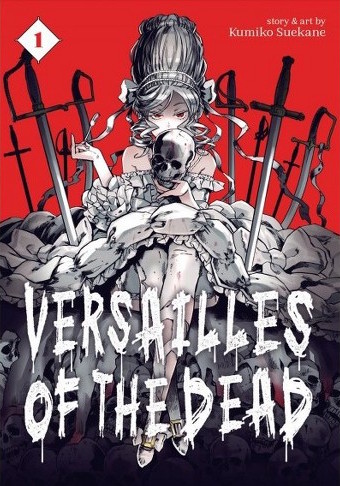Kumiko Suekane’s Versailles of the Dead feels like a kissing cousin of Seth Grahame-Smith’s Pride & Prejudice & Zombies. It’s a clever and handsomely drawn manga that also inserts zombies into a well-known story for shock value: who knew the real cause of the French Revolution was an outbreak of “resurrection illness”? The net result, however, is so intentionally kitschy that it sometimes holds the reader at arm’s length, inviting us to appreciate the imagination and research that went into creating Versailles of the Dead without fully drawing us into the story.
You might reasonably think that the zombies were Versailles of the Dead’s most gonzo element, but you’d be wrong: it’s actually Suekane’s decision to invent a sibling for Marie Antoinette. This sibling — a twin brother named Albert — is Marie’s doppelgänger, a handsome lad with the same high cheekbones and pert nose as his infamous sister. En route to Marie’s nuptials, their carriage is ambushed by zombies, forcing Albert to impersonate his sister after she meets a gruesome end. Albert’s identity is quickly discovered by a handful of courtiers, all of whom are invested enough in preserving the status quo at Versailles that they conspire to look the other way, even when rumors surface that Albert beheaded his own sister.
Watching Albert step into the role of Dauphine is fun; he embraces the opportunity to manipulate courtiers through gossip and flirtation, exploiting rivalries within the court to his own advantage. The supernatural interludes, by contrast, sometimes feel like an afterthought, rather than a vital part of the story. Though the zombies are handled in a straightforward fashion, Suekane relies too much on flash-booms, jump cuts, and smudgy silhouettes to imply that certain members of the French court are possessed. Suggestion is an important tool for generating suspense, of course, but here it feels like a half-baked effort at world-building — what if there were demons in eighteenth century France, too? Not everything needs to be explained in a baldly literal fashion, of course, but the demonic angle feels like one accessory too many on a busy outfit.
If the supernatural intrigue is more afterthought than essential element, the artwork is sumptuous, capturing the opulence of Versailles without overwhelming the reader. Suekane’s secret? Lavishing attention on character designs rather than material objects, allowing the intricacy of the hairstyles, gowns, and frock coats to be the focal point of most panels. That approach gives her breathing room to draw the kind of subtle but important details that help establish the characters’ true natures. Albert, for example, never fully disappears into his sister’s clothes and wigs; the twinkle in his eye and the boldness of his carriage are conspicuous signs of his male upbringing, even though he looks ravishing as a woman. Other characters’ personalities are just as thoughtfully embodied through costume and movement. Madame du Barry, the Dauphine’s great rival, makes a dramatic display of her décolletage, framing her chest in a wreath of feathers that accentuate du Barry’s mature womanhood — a not-so-subtle attempt to assert her power and experience over a teenage interloper.
It’s this level of thoughtfulness that helped me soldier through the more clumsy parts of the story, where characters solemnly explain why Albert’s marriage must go forward for “the good of our two countries,” and Madame du Barry thinks in complete Wikipedia paragraphs. (Her internal monologues are surprisingly dull for such a canny strategist.) I’m not sure that all of the plot lines will eventually converge in a satisfying way — there’s a lot of supernatural silliness — but I find Albert a compelling character, a skilled political operator who revels in his ability to sow discord. Count me in for volume two.
VERSAILLES OF THE DEAD, VOL. 1 • STORY & ART BY KUMIKO SUEKANE • TRANSLATION BY JOCELYNE ALLEN • SEVEN SEAS • RATED TEEN (PARTIAL NUDITY, MILD GORE, VIOLENCE) 172 pp.



